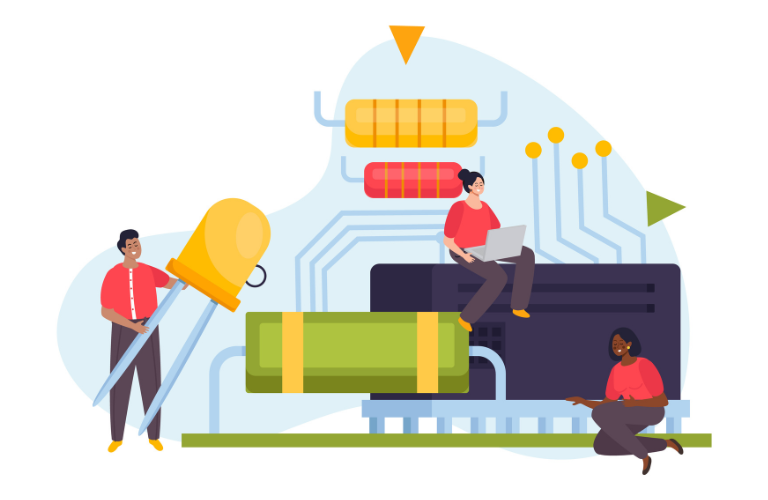Blockchain Integration with Laravel empowers developers to create secure, transparent, and decentralized applications (dApps) with ease. By combining Laravel’s robust PHP framework with blockchain APIs like Web3.js and web3.php, you can build powerful backends for managing transactions, smart contracts, and more.
This article provides a comprehensive guide to integrating blockchain with Laravel, including a step-by-step transaction logger demo. We’ll highlight security and transparency benefits, address pain points like slow performance, and offer actionable solutions for seamless development. Whether you’re building a cryptocurrency wallet or a decentralized marketplace, this guide equips you with the tools to succeed.
Table of Contents
Why Use Blockchain Integration with Laravel?
Laravel’s developer-friendly ecosystem makes it an excellent choice for blockchain projects. Its modular structure, combined with blockchain’s decentralized architecture, enables robust dApp development. Here’s why this integration stands out:
- Ease of Use: Laravel’s familiar syntax reduces the learning curve for blockchain integration.
- API Support: Tools like Web3.js and web3.php enable seamless interaction with Ethereum and other blockchains.
- Scalability: Laravel’s Eloquent ORM and caching handle blockchain data efficiently, ensuring performance.
This synergy allows developers to create secure, scalable dApps, solving issues like centralized vulnerabilities and data tampering.
Understanding the Synergy
Blockchain is a decentralized ledger that records data in immutable, cryptographically linked blocks. This ensures transparency and trust, ideal for applications requiring no intermediaries. Laravel complements blockchain by providing a reliable backend for smart contract interactions, transaction logging, and user authentication. By integrating blockchain APIs, Laravel communicates with networks like Ethereum, enabling features like wallet management and token transfers. This combination creates a robust foundation for dApps, addressing challenges like slow transaction processing.
Setting Up Your Laravel Environment
To start with Blockchain Integration with Laravel, prepare your development environment:
- Install Laravel via Composer:
composer create-project –prefer-dist laravel/laravel blockchain-app - Add web3.php for server-side Ethereum interactions:
composer require web3p/web3.php - Install Node.js and Web3.js for client-side blockchain tasks:
npm install web3 - Set up an Ethereum node using providers like Infura or run a local node with Ganache.
These steps ensure your Laravel app is ready for blockchain integration, minimizing setup complexity.
Integrating Web3.js with Laravel
Web3.js is a JavaScript library for Ethereum blockchain interactions, handling tasks like wallet authentication. Here’s how to integrate it with Laravel.
Client-Side Web3.js Setup
Create a frontend interface to connect users’ MetaMask wallets and display their address and balance. Add this code to a Laravel Blade template (e.g., resources/views/web3-integration.blade.php):
<!DOCTYPE html>
<html>
<head>
<title>Blockchain Wallet Integration</title>
<script src="https://cdn.jsdelivr.net/npm/web3@latest/dist/web3.min.js"></script>
</head>
<body>
<button id="connectWallet">Connect Wallet</button>
<p id="walletAddress">Wallet Address: Not connected</p>
<p id="balance">Balance: Not connected</p>
<script>
const connectWallet = async () => {
if (window.ethereum) {
const web3 = new Web3(window.ethereum);
try {
const accounts = await window.ethereum.request({ method: 'eth_requestAccounts' });
const walletAddress = accounts[0];
document.getElementById('walletAddress').textContent = `Wallet Address: ${walletAddress}`;
const balance = await web3.eth.getBalance(walletAddress);
document.getElementById('balance').textContent = `Balance: ${web3.utils.fromWei(balance, 'ether')} ETH`;
} catch (error) {
console.error('Error connecting wallet:', error);
}
} else {
alert('Please install MetaMask!');
}
};
document.getElementById('connectWallet').addEventListener('click', connectWallet);
</script>
</body>
</html>This code enables users to connect their MetaMask wallet, enhancing user interaction with your dApp.
Server-Side Integration with web3.php
For server-side blockchain tasks, use web3.php. Create a BlockchainService class (app/Services/BlockchainService.php):
<?php
namespace App\Services;
use Web3\Web3;
use Web3\Contract;
class BlockchainService {
protected $web3;
protected $contract;
public function __construct() {
$provider = env('BLOCKCHAIN_PROVIDER', 'http://localhost:8545');
$this->web3 = new Web3($provider);
$contractAddress = env('CONTRACT_ADDRESS');
$abi = json_decode(file_get_contents(base_path('contracts/MyContract.json')));
$this->contract = new Contract($provider, $abi);
$this->contract->at($contractAddress);
}
public function callSmartContractFunction($functionName, $params) {
$result = null;
$this->contract->call($functionName, $params, function ($err, $res) use (&$result) {
if ($err !== null) {
throw new \Exception($err->getMessage());
}
$result = $res;
});
return $result;
}
}
?>Update your .env file with provider details:
BLOCKCHAIN_PROVIDER=https://mainnet.infura.io/v3/your-infura-key
CONTRACT_ADDRESS=0xYourContractAddressThis setup enables your Laravel backend to interact with smart contracts securely.
Building a Transaction Logger Demo
To showcase Blockchain Integration with Laravel, let’s build a transaction logger that records Ethereum transactions in your database. This demo ensures transparency and auditability.
Step 1: Create a Transaction Model
Generate a model and migration:
php artisan make:model Transaction -mUpdate the migration (database/migrations/xxxx_create_transactions_table.php):
<?php
use Illuminate\Database\Migrations\Migration;
use Illuminate\Database\Schema\Blueprint;
use Illuminate\Support\Facades\Schema;
class CreateTransactionsTable extends Migration {
public function up() {
Schema::create('transactions', function (Blueprint $table) {
$table->id();
$table->string('tx_hash')->unique();
$table->string('from_address');
$table->string('to_address');
$table->decimal('amount', 20, 8);
$table->string('status')->default('pending');
$table->timestamps();
});
}
public function down() {
Schema::dropIfExists('transactions');
}
}Run the migration:
php artisan migrateStep 2: Create a Transaction Controller
Generate a controller:
php artisan make:controller TransactionControllerUpdate the controller (app/Http/Controllers/TransactionController.php):
<?php
namespace App\Http\Controllers;
use App\Services\BlockchainService;
use App\Models\Transaction;
use Illuminate\Http\Request;
class TransactionController extends Controller {
protected $blockchainService;
public function __construct(BlockchainService $blockchainService) {
$this->blockchainService = $blockchainService;
}
public function logTransaction(Request $request) {
$validated = $request->validate([
'tx_hash' => 'required|unique:transactions',
'from_address' => 'required',
'to_address' => 'required',
'amount' => 'required|numeric',
]);
$transaction = Transaction::create($validated);
return response()->json(['message' => 'Transaction logged', 'data' => $transaction], 201);
}
}Step 3: Define a Route
Add a route in routes/api.php:
Route::post('/log-transaction', [TransactionController::class, 'logTransaction']);Step 4: Test the Logger
Test the endpoint with a POST request:
curl -X POST http://your-laravel-app.test/api/log-transaction \
-H "Content-Type: application/json" \
-d '{"tx_hash":"0x123...","from_address":"0xFromAddress","to_address":"0xToAddress","amount":0.1}'This logs transactions in your database, creating a transparent audit trail.
Security and Transparency Benefits
Blockchain Integration with Laravel offers compelling advantages:
- Decentralization: Eliminates single points of failure, ensuring data integrity.
- Transparency: Immutable ledgers provide verifiable transaction records.
- Security: Cryptographic protections prevent unauthorized data changes.
Security Best Practices
- Store private keys securely using encryption.
- Audit smart contracts to eliminate vulnerabilities.
- Use testnets like Ropsten for development to avoid real fund risks.
- Keep sensitive data in .env files.
These practices ensure your dApp is secure and efficient.
Performance Optimization
Blockchain transactions can be slow. Optimize your Laravel dApp with these tips:
- Use webhooks (e.g., Chaingateway) for real-time transaction updates.
- Batch transactions to reduce gas fees.
- Cache blockchain data in Laravel to minimize API calls.
These shortcuts enhance performance and save development time.
Use Cases
Blockchain Integration with Laravel supports diverse applications:
- Cryptocurrency Wallets: Manage digital assets securely.
- Decentralized Marketplaces: Enable peer-to-peer trading.
- Voting Systems: Ensure tamper-proof, transparent voting.
These use cases leverage blockchain’s trustless nature, enhanced by Laravel’s ecosystem.
Conclusion
Blockchain Integration with Laravel enables developers to build secure, transparent dApps with ease. By leveraging Web3.js and web3.php, you can create robust backends for transaction logging, smart contract interactions, and more. The transaction logger demo illustrates practical implementation, while optimization tips and security practices ensure efficiency and reliability. With Laravel’s flexibility and blockchain’s decentralized power, you can address performance and security challenges, delivering innovative dApps in 2025 and beyond.
FAQs
1. What is Blockchain Integration with Laravel?
Blockchain Integration with Laravel involves using Laravel, a PHP framework, to build decentralized app (dApp) backends by connecting to blockchain networks like Ethereum via APIs such as Web3.js or web3.php. It allows developers to manage transactions, smart contracts, and user authentication securely, leveraging Laravel’s scalability and blockchain’s transparency.
2. Why should I use Laravel for blockchain development?
Laravel is ideal for blockchain development due to its modular structure, ease of use, and support for APIs like web3.php. It simplifies backend tasks like transaction logging and user management, while blockchain ensures security and decentralization, making it perfect for dApps like wallets or marketplaces.
3. How do I set up Laravel for blockchain integration?
To set up Laravel for blockchain:
- Install Laravel using composer create-project laravel/laravel blockchain-app.
- Add web3.php with composer require web3p/web3.php.
- Install Web3.js via npm install web3 for frontend interactions.
- Connect to an Ethereum node using providers like Infura or a local node like Ganache.
4. Can I build a transaction logger with Laravel and blockchain?
Yes, you can build a transaction logger by integrating Laravel with a blockchain API. Create a Laravel model to store transaction details (e.g., tx_hash, addresses, amount), use web3.php to fetch blockchain data, and log it via a controller. The article’s demo shows how to implement this with a simple API endpoint.
5. What are the security benefits of Blockchain Integration with Laravel?
Blockchain Integration with Laravel offers:
- Decentralization: No single point of failure.
- Transparency: Immutable transaction records.
- Security: Cryptographic protection against tampering.
6. How can I optimize performance for a Laravel blockchain app?
To optimize performance:
- Use webhooks for real-time transaction updates.
- Batch transactions to reduce gas fees.
- Cache blockchain data in Laravel to minimize API calls.
7. What are some use cases for Blockchain Integration with Laravel?
Common use cases include:
- Cryptocurrency wallets for secure asset management.
- Decentralized marketplaces for peer-to-peer trading.




